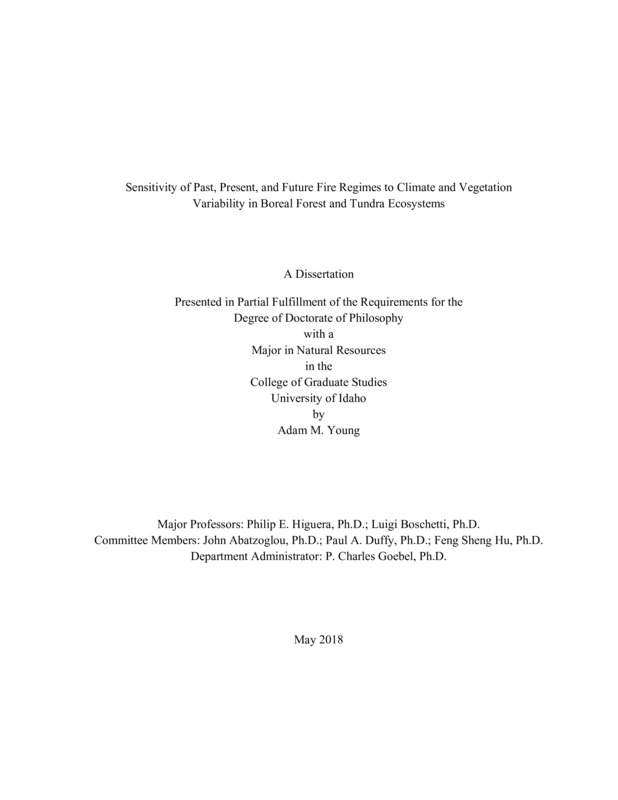Sensitivity of Past, Present, and Future Fire Regimes to Climate and Vegetation Variability in Boreal Forest and Tundra Ecosystems
Young, Adam Mason. (2018-05). Sensitivity of Past, Present, and Future Fire Regimes to Climate and Vegetation Variability in Boreal Forest and Tundra Ecosystems. Theses and Dissertations Collection, University of Idaho Library Digital Collections. https://www.lib.uidaho.edu/digital/etd/items/young_idaho_0089e_11336.html
- Title:
- Sensitivity of Past, Present, and Future Fire Regimes to Climate and Vegetation Variability in Boreal Forest and Tundra Ecosystems
- Author:
- Young, Adam Mason
- ORCID:
- http://orcid.org/0000-0003-2668-2794
- Date:
- 2018-05
- Keywords:
- Arctic Tundra Boreal Forests Climate Change Fire Ecology Statistical Modelling
- Program:
- Natural Resources
- Subject Category:
- Ecology; Natural resource management; Climate change
- Abstract:
-
Wildfire activity in North American boreal forest and tundra ecosystems is strongly controlled by climate, indicating the potential for widespread fire-regime shifts in response to ongoing and future climate change. This dissertation focuses on understanding how fire regimes in boreal forest and tundra ecosystems respond to variability in past, present, and future climate.
Chapter 1 addresses how climate, vegetation, and topography control the spatial distribution of fire occurrence in Alaskan boreal forest and tundra ecosystems. Through statistical modelling, I found that climate was the primary control of historical fire activity. Informing these statistical models with 21st-century climate projections suggests tundra and forest-tundra ecosystems will be particularly vulnerable to fire-regime shifts, due to increasing summer temperatures. In some areas, fire may become four times more likely to occur by 2100, relative to the past 6,000-35,000 years.
In Chapter 2, I studied the importance of vegetation as a control of fire activity across North American boreal forests, using continental-scale fire and vegetation datasets spanning the past several decades. After climate, fire activity was most strongly linked to landscape tree cover (%). The likelihood of burning was also not independent of past fire, suggesting negative fire-vegetation feedbacks exist across North American boreal forests. These feedbacks are estimated to have reduced total area burned by ≈ 2.7-3.6 ×10^6 ha (4-5%) from 1981-2016, relative to expectations if there were no feedbacks. While these negative fire-vegetation feedbacks may offset climatically driven increases in fire activity for several decades, continued warming and increasing aridity will likely overwhelm the mediating effects of vegetation by the mid- to late-21st century.
In Chapter 3, I evaluate the ability of the statistical models from Chapter 1 to project fire regimes outside of the observational period (i.e., 1950-2009 CE). I informed these models with GCM data from 850-1850 CE, and compared these paleo-projections to independent fire histories derived from lake-sediment records. The accuracy of the paleo-projections varied regionally, with uncertainty highest in regions close to an observed temperature threshold to burning. These results highlight how threshold relationships can cause significant uncertainty in anticipating the timing, location, and magnitude of future ecosystem change.
- Description:
- doctoral, Ph.D., Natural Resources -- University of Idaho - College of Graduate Studies, 2018-05
- Major Professor:
- Higuera, Philip E; Boschetti, Luigi
- Committee:
- Abatzoglou, John; Duffy, Paul A; Hu, Feng Sheng
- Defense Date:
- 2018-05
- Identifier:
- Young_idaho_0089E_11336
- Type:
- Text
- Format Original:
- Format:
- application/pdf
- Rights:
- In Copyright - Educational Use Permitted. For more information, please contact University of Idaho Library Special Collections and Archives Department at libspec@uidaho.edu.
- Standardized Rights:
- http://rightsstatements.org/vocab/InC-EDU/1.0/

